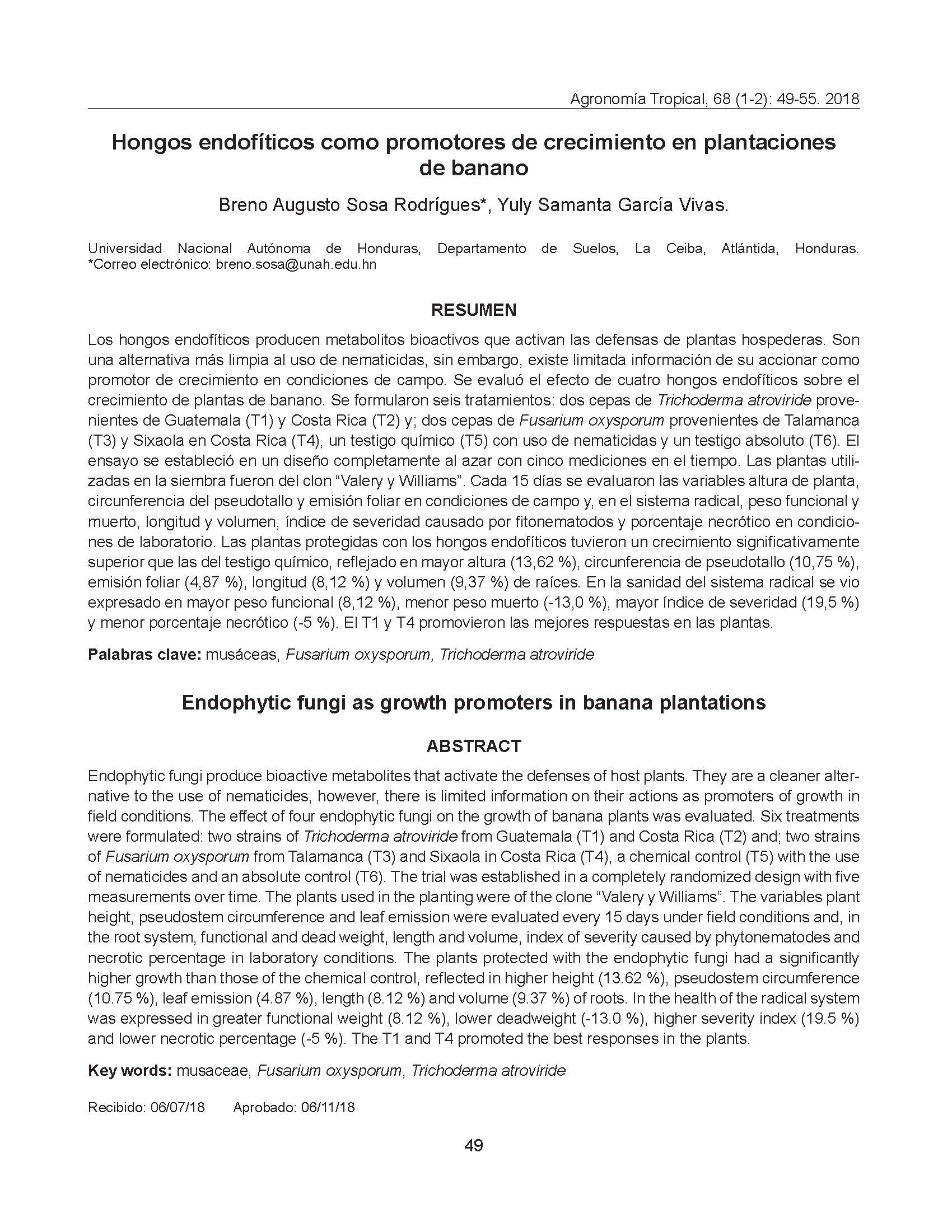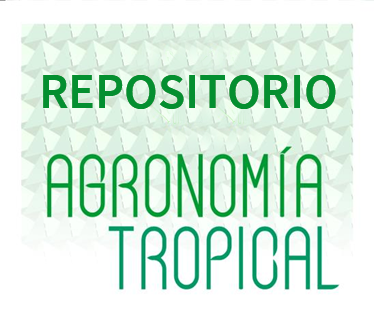Endophytic fungi as growth promoters in banana plantations
Abstract
Endophytic fungi produce bioactive metabolites that activate the defenses of host plants. They are a cleaner alter- native to the use of nematicides, however, there is limited information on their actions as promoters of growth in field conditions. The effect of four endophytic fungi on the growth of banana plants was evaluated. Six treatments were formulated: two strains of Trichoderma atroviride from Guatemala (T1) and Costa Rica (T2) and; two strains of Fusarium oxysporum from Talamanca (T3) and Sixaola in Costa Rica (T4), a chemical control (T5) with the use of nematicides and an absolute control (T6). The trial was established in a completely randomized design with five measurements over time. The plants used in the planting were of the clone “Valery y Williams”. The variables plant height, pseudostem circumference and leaf emission were evaluated every 15 days under field conditions and, in the root system, functional and dead weight, length and volume, index of severity caused by phytonematodes and necrotic percentage in laboratory conditions. The plants protected with the endophytic fungi had a significantly higher growth than those of the chemical control, reflected in higher height (13.62 %), pseudostem circumference (10.75 %), leaf emission (4.87 %), length (8.12 %) and volume (9.37 %) of roots. In the health of the radical system was expressed in greater functional weight (8.12 %), lower deadweight (-13.0 %), higher severity index (19.5 %) and lower necrotic percentage (-5 %). The T1 and T4 promoted the best responses in the plants.
Downloads
References
• Benzing, A. 2001. Agricultura Orgánica, Fundamentos para la Región Andina, Alemania, Neckar-Verlag, 663 p.
• Clay, K; Hardy, TN; Hammond, AM. 1985. Fungal endophytes of Cyperus and their effect on an insect hervibore. American Journal of Botany 72:1284-1289.
• FAO (Organización de las Naciones Unidas para la Alimentación y la Agricultura, Italia). 2018. Situación del mercado de banano – resultados preliminares relativos a 2017, Roma. 8 p. Disponible en: http://bit.ly/3amRyn5
• Gao, F; Dai, C; Liu, X. 2010. Mechanisms of fungal endophytes in plant protection against pathogens. African Journal of Microbiology Research 4(13):1346-1351. Disponible en: https://bit.ly/2TCz238
• Guzmán, P. 2011. El nematodo barrenador (Radopholus similis [Cobb] Thorne) del banano y plátano. Revista Luna Azul, (33):137-153. Disponible en: http://bit.ly/2PIgOMP
• Miguel, AH; Jersys, A; Marrero, R; Hidalgo, D. 2016. Efecto de KlamiC® en la estimulación del crecimiento de vitroplantas de plátanos y bananos. Cultrop. 37 (4). http://dx.doi.org/10.13140/RG.2.2.25696.69120
• Montiel, C; Sosa, L; Medrano, C; Romero, D. 1997. Nematodos fitoparasitarios en plantaciones de plantano (Musa AAB) de la margen del rio chana, estado Zulia, Venezuela, Departamento Fitoparasitario, Revista Facultad de Agronomía LUZ, 14: 245-251.
• Morales, G. 2014. Bioprospección de hongos endófitos para el control biológico del nematodo barrenador Radopholus similis (Cobb) Thorn en el cultivo del banano. Tesis maestría. Instituto tecnológico de Costa Rica. pp 54. Disponible en: http://bit.ly/2Twcrp
• Pocasangre, L; Sikora, RA; Araya M. 2001. Estado actual de la situación nematológica en los bananos y plátanos en América Latina, PROMUSA, InfoMusa. 10:1-12.
• Pocasangre, LE; Menjivar, RD; Zum, A; Riveros, AS; Rosales, FE; Sikora, RA. 2006. Hongos endofíticos como agentes biológicos de control de fitonematodos en banano. Memorias: XVII Reunión Internacional Acorbat: banano un negocio sustentable, del 15 al 20 de octubre de 2006, Joinville, Santa Catarina, Brasil, 2006, 1:249-254. Disponible en: http://bit.ly/2IdM423
• Romero, RJ. 2018. Uso de hongos del género Trichoderma spp. como controlador de nematodos en el cultivo de banano. Tesis pregrado. Universidad Técnica de Machala, Machala, Ecuador. pp 26. Disponible en: http://bit.ly/38ikATy
• Sánchez, FR; Sánchez, OB; Sandoval,YK; Ulloa, B; Armendáriz, GB; García, MM; Macías, R. 2013. Hongos endófitos: fuente potencial de metabolitos secundarios bioactivos con utilidad en agricultura y medicina. TIP Revista Especializada en Ciencias Químico - Biológicas, 16(2), 132-146.
• Schulz, B; Boyle, C. 2005. The endophytic continuum. Mycological Research 109(6):661-686.
• Sikora, RA, Pocasangre, LA. 2004. New Technologies to increase root health and crop production. InfoMusa 13(2):25-29.





